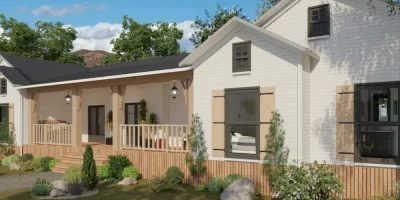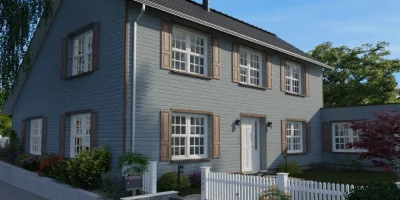Architecture is a fascinating journey through time, telling the story of human creativity and innovation.
From the grand cathedrals of the Middle Ages to the sleek skyscrapers of today, our built environment reflects the ever-changing needs, values, and technologies of society.
As designers and builders, we often find ourselves at the crossroads of tradition and innovation. Should we embrace the timeless elegance of traditional architecture or push the boundaries with modern design?
The answer isn’t always straightforward, and that’s what makes our field so exciting.
In this article, we’ll explore the key differences between traditional and modern architecture. We’ll dive into their unique characteristics, advantages, and challenges. But more importantly, we’ll discuss how understanding both styles can elevate your design and help you create spaces that truly resonate with your clients.
Traditional Architecture: Timeless Elegance
When you think of traditional architecture, images of grand colonial homes, charming cottages, or stately Victorian mansions might come to mind. But what exactly makes a building “traditional”?
Traditional architecture is all about honoring the past. It draws inspiration from historical styles and cultural heritage, creating buildings that feel familiar and comforting. These designs often feature symmetry, ornate details, and natural materials that have stood the test of time.
Some popular traditional architectural styles include:
- Colonial

- Victorian
- Tudor
- Mediterranean
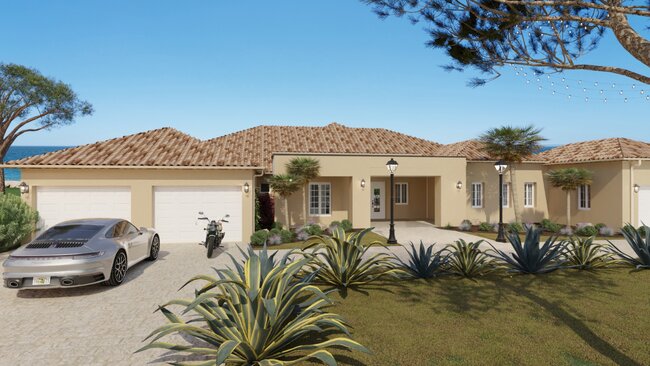
- Craftsman
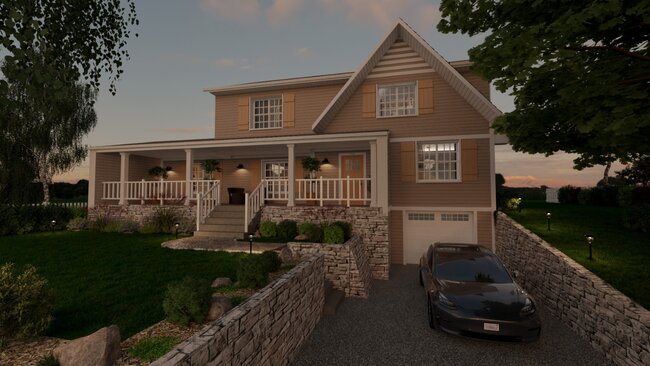
Each of these styles has its own unique characteristics, but they all share a common thread: a respect for historical design principles and craftsmanship.
Traditional Architecture Materials
Traditional style architecture relies on a specific set of building materials that contribute to its timeless and classic aesthetic. Here are some key materials commonly used in traditional architecture:
- Wood is a cornerstone material in traditional design. Rich wood tones like cherry, mahogany, and oak are often featured in flooring, trim work, and built-in elements like cabinetry and bookshelves.
- Stone is another fundamental traditional material, valued for its strength, longevity, and natural beauty. It’s frequently used for exterior facades, fireplaces, and landscaping elements. Traditional homes may incorporate limestone, granite, or local stone varieties to create a sense of permanence and connection to the surrounding environment.
- Brick is a classic choice for traditional exteriors, offering durability and a timeless appearance. Clay bricks in warm reds, browns, or earth tones are common in traditional architecture, often laid in intricate patterns or bonds.
- Plaster is widely used in traditional interiors for walls and ceilings. It provides a smooth, elegant finish and can be molded into decorative elements like crown moldings and ceiling medallions.
- Metal finishes play an important role in traditional design. Brass, oil-rubbed bronze, and silver are commonly used for hardware, light fixtures, and decorative accents.
By combining these materials thoughtfully, traditional architecture creates a sense of timelessness, craftsmanship, and enduring beauty. The use of natural, high-quality materials is a hallmark of traditional style, contributing to its lasting appeal and ability to age gracefully over time.
The Pros and Cons of Traditional Architecture
One of the biggest advantages of traditional architecture is its timeless appeal. A well-designed traditional home can look just as beautiful and relevant today as it did a century ago. Plus, these homes often blend seamlessly with established neighborhoods, making them great candidates for resale value.
Traditional architecture often showcases high levels of craftsmanship and artisanal skills. From intricate woodwork to hand-carved stone details, these elements add unique character and value to a home. This emphasis on craftsmanship can result in buildings with a level of detail and quality that is often hard to replicate in mass-produced modern construction.
It also often reflects the cultural heritage and historical context of a region. These buildings serve as tangible links to the past, preserving architectural traditions and craftsmanship techniques that might otherwise be lost. They contribute to a sense of place and cultural identity, which can be particularly valuable in an increasingly globalized world.
But traditional homes aren’t without their challenges.
One of the biggest challenges with traditional architecture is energy efficiency. Many traditional buildings were constructed before modern insulation techniques and energy-saving technologies were developed. This can lead to higher heating and cooling costs and an increased carbon footprint.
Traditional buildings can also be more expensive to construct due to initial expenses, labor costs, ongoing maintenance, and even material challenges. For example, some materials may be scarce, difficult to source, and complex to install.
Despite these challenges, there’s growing interest in blending traditional architectural elements with modern technologies and sustainable practices. This approach aims to preserve cultural heritage while addressing contemporary needs for efficiency, sustainability, and functionality. The key lies in finding a balance between respecting traditional methods and embracing innovative solutions to overcome these challenges.
Modern Architecture: Embracing Innovation
When you think of modern architecture, sleek skyscrapers, minimalist homes, and innovative structures might come to mind. But what exactly defines “modern” architecture?
Modern architecture breaks away from historical styles, focusing instead on form following function, clean lines, and the innovative use of materials and technology. These designs often feature open floor plans, large windows, and a seamless integration with the surrounding environment.
Some popular modern architectural styles include:
- Mid-century Modern
- International
- Bauhaus
- Brutalism
- Deconstructivism
Each of these styles has its own unique characteristics, but they all share common threads: a rejection of ornamental excess, an emphasis on functionality, and a celebration of new materials and technologies.
Modern Architecture Materials
Modern architecture utilizes a wide range of materials, often in innovative ways. Here are some key materials commonly used in modern architecture:
- Glass is a cornerstone of modern design, used extensively for windows, walls, and even structural elements. It allows for abundant natural light and creates a sense of openness and connection with the outdoors.
- Steel is fundamental in modern construction, valued for its strength and versatility. It’s used in structural frameworks, allowing for open floor plans and dramatic cantilevers.
- Concrete is a favorite of modern architects for its plasticity and raw aesthetic. It can be molded into various forms and left exposed for a brutalist look or finished for a sleeker appearance.
- Engineered wood products like cross-laminated timber are gaining popularity in modern architecture for their sustainability and structural capabilities.
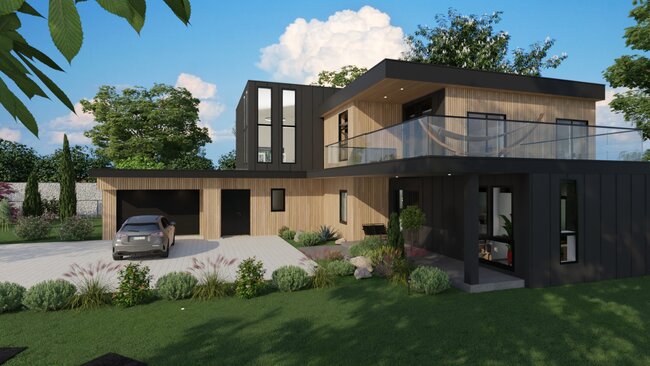
By combining these materials thoughtfully, modern architecture creates spaces that are functional, efficient, and aesthetically striking. The use of industrial and technologically advanced materials is a hallmark of modern style, contributing to its forward-looking appeal and ability to push the boundaries of design.
The Pros and Cons of Modern Architecture
One of the biggest advantages of modern architecture is its efficiency and functionality. Modern designs often maximize space usage, incorporate energy-efficient technologies, and adapt easily to contemporary lifestyles.
The open floor plans and large windows typical of modern architecture create bright, airy spaces that can feel larger than their actual square footage.
Modern architecture also offers great flexibility in design. Without the constraints of traditional styles, architects can create unique, personalized spaces that reflect the specific needs and tastes of their clients. This freedom allows for innovative solutions to complex design challenges.
Furthermore, modern architecture often emphasizes sustainability. Many modern buildings incorporate green technologies like solar panels, rainwater harvesting systems, and energy-efficient appliances. The use of sustainable materials and construction methods can result in buildings with a lower environmental impact.
However, modern architecture isn’t without its challenges.
One of the main criticisms of modern architecture is that it can sometimes feel cold or impersonal. The minimalist aesthetic and use of industrial materials may lack the warmth and character that some people associate with home.
Modern buildings can also be expensive to construct, especially when incorporating cutting-edge technologies or unusual design elements. While they may be more energy-efficient in the long run, the initial costs can be higher than those of traditional construction.
Despite these challenges, modern architecture continues to evolve and adapt. Many architects are finding ways to blend modern principles with warmer, more inviting elements, and to incorporate sustainable practices that address environmental concerns. The key lies in balancing innovation with livability, creating spaces that are not just visually striking, but also comfortable and functional for everyday use.
Comparing Traditional Architecture and Modern Architecture
While traditional and modern architecture may seem like opposites, they each have unique strengths and challenges. Let’s compare these two styles across several key aspects:
Design Philosophy
- Traditional: Emphasizes historical continuity, cultural heritage, and time-tested design principles.
- Modern: Focuses on innovation, functionality, and breaking away from historical constraints.
Aesthetics
- Traditional: Features ornate details, symmetry, and familiar forms.
- Modern: Embraces minimalism, asymmetry, and novel, sometimes unconventional shapes.
Materials
- Traditional: Relies on natural materials like wood, stone, and brick.
- Modern: Utilizes a mix of natural and industrial materials, including glass, steel, and concrete.
Space Utilization
- Traditional: Often compartmentalized spaces with specific functions.
- Modern: Favors open floor plans and multifunctional spaces.
Energy Efficiency
- Traditional: Can be challenging to make energy-efficient without significant modifications.
- Modern: Often designed with energy efficiency in mind from the start.
Craftsmanship
- Traditional: Emphasizes artisanal skills and handcrafted details.
- Modern: Focuses on precision engineering and innovative construction techniques.
Despite these differences, it’s important to note that the lines between traditional and modern architecture are increasingly blurred. Many contemporary designs successfully blend elements from both styles, creating spaces that honor the past while embracing the future. The key is to understand the strengths of each approach and apply them thoughtfully to create buildings that are both beautiful and functional.
Start Using Cedreo’s Architecture Design Software
Whether you’re leaning towards traditional elegance or modern innovation, Cedreo’s architecture design software empowers builders and designers to bring their visions to life quickly and efficiently.
Here’s how Cedreo can revolutionize your design process:
- Streamlined Design Process: With Cedreo, you can create complete 3D architectural designs in under 2 hours. This feature allows you to focus more on creativity and client satisfaction rather than getting bogged down in technical details.
- Versatile Design Capabilities: Build site plans, floor plans, cross-section plans, elevation views, roof plans, as well as 3D exterior and interior renderings.
- Extensive Material and Furnishing Library: Experiment with different styles and finishes with over 7,000 customizable resources, including materials, furnishings, and decor elements.
- Real-Time 3D Visualization: As you draw in 2D, Cedreo generates a 3D model in real-time. This feature allows you to instantly see how your design choices impact the overall look and feel of the space.
Create Your Next Design with Cedreo.
With today’s 3D visualization tools, you don’t have to choose between traditional charm and modern flair. Architecture software like Cedreo allows you to experiment with both styles, blend elements seamlessly, and present your ideas in stunning detail. Whether restoring a historic building or designing a futuristic home, 3D visualization is your secret weapon for bringing architectural visions to life.
Want to see how a wrap-around porch would look on that Colonial-style home? Or curious about adding dormer windows to a Cape Cod cottage?
With Cedreo, you can try out these ideas in minutes, not days, and create a design that will “wow” your clients.


